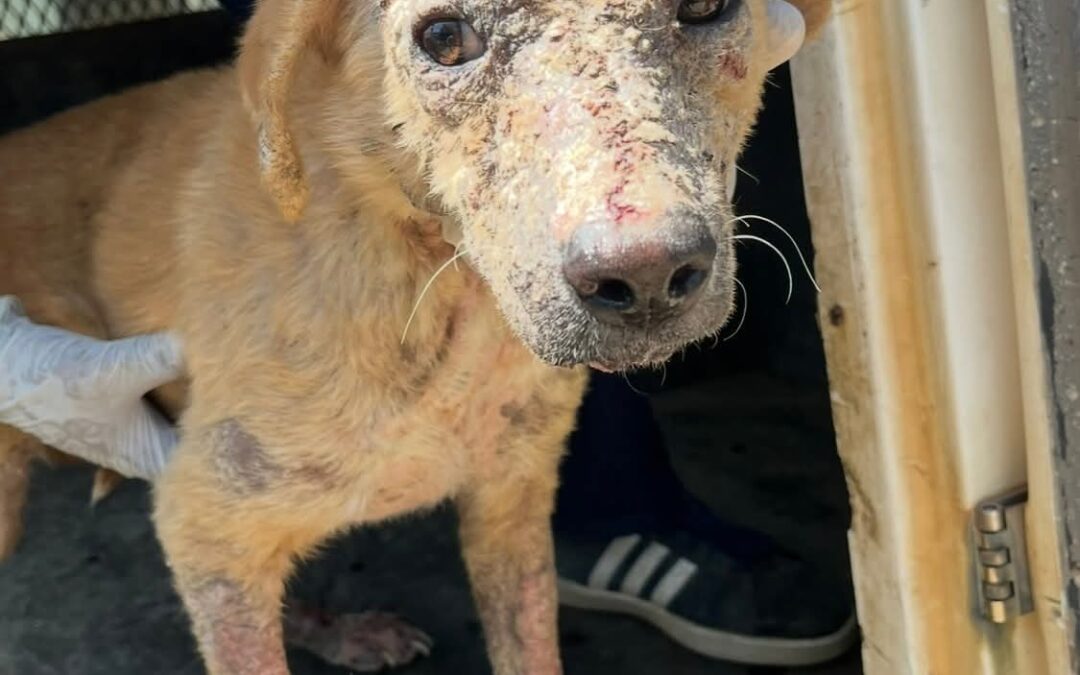The skin condition known as mange is often assumed to be only found on stray or neglected dogs. However, mange can happen to any dog, even the ones in loving homes who are well cared for. The most common cases of mange seen in dogs are sarcoptic mange, which is also known as scabies, and demodectic, or demodex, mange. Let’s focus on the one that is most contagious, which is sarcoptic.
Mange is caused by mites that live on or in the skin. While the mite that causes demodectic mange is a part of normal skin flora, the Sarcoptes scabiei mite is a parasite that easily passes from dog to dog. They are commonly found on wolves, coyotes, and foxes. While these mites can be transmitted to humans, they do not tend to last as long on human skin, and they can not complete their lifecycle on a noncanine host. The male and female parasites mate on the surface of the dog’s skin, then the female parasite will burrow deep within hair follicles to lay eggs. Once hatched, the larvae then feed on the dog’s skin, resulting in almost constant itching. Scabies is not exclusively due to bad hygiene, but it can be a serious threat to a neglected dog’s health.
Symptoms of scabies can appear as soon as 10 days post-exposure and as late as 8 weeks later. The most common places to see mange develop are the tips of the ears, chest area, elbows, hocks, and the belly. Scabies is extremely itchy, which will result in constant scratching or chewing on the affected areas. Other symptoms include the skin appearing red or rash-like, thick yellow crusting of the skin, and hair loss as a result of the open wounds from secondary bacterial or yeast infections on the skin that itch or are scratched at.
To diagnose scabies, a vet may perform a skin scrape. However, the mite that causes scabies may not always be seen under the microscope, because it burrows so deeply into the skin. Scabies is usually diagnosed after checking the physical appearance of the wounds and after ruling out infections caused by bacteria or yeast.
Once diagnosed, immediate treatment may include a medicated dip or bath, combined with the use of various topical applications used to treat scabies. Possible medications used could be the administration of a steroid to decrease skin inflammation, Selamectin, Fipronil, Isoxazoline, and Ivermectin. Ivermectin is never used in dogs that carry a gene known as the “MDR1” gene; those breeds include Collies, Collie mixes, Shetland sheepdogs, Australian shepherds, and Old English sheepdogs. If you live in a multi-dog household, it is safe to assume that if one dog has scabies, they all have it, and it may be prudent to treat every dog. Environmental controls, such as discarding all bedding or washing everything in a bleach solution, may also be needed to get control of the situation.
Scabies will always require a trip to the vet for treatment. Puppies, older dogs, and dogs with compromised immune systems can become seriously ill from secondary infections that can become serious and even fatal. The general prognosis of scabies in dogs is that it is highly treatable if pet owners follow the instructions of bathing and administer all of the medications issued.
If you live in our area and walk in the woods, assume that you are walking in an area frequented by foxes and sometimes coyotes. Therefore, be on alert if your dogs start to itch in the cooler weather that normally does not result in skin allergies.
If you have any questions, please feel free to email me at heidi@fouronthefloordogtraining.net.
Heidi Clayton started Four On the Floor Dog Training to provide positive, reward-based dog training in South Jersey. She breeds, trains and shows bull terriers under the SoraBully’s Bull Terriers kennel name. Email questions to heidi@fouronthefloordogtraining.net or learn more at https://fouronthefloordogtraining.net
















